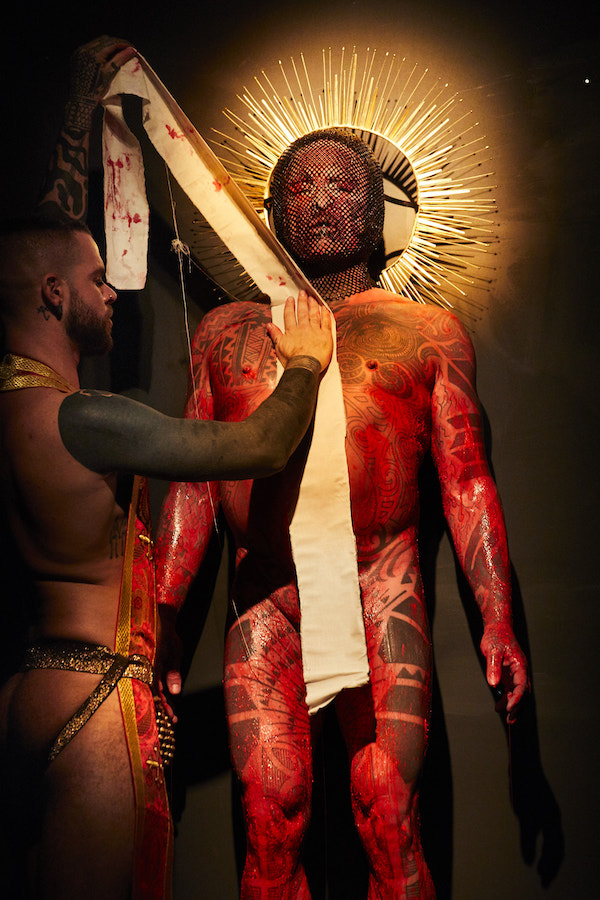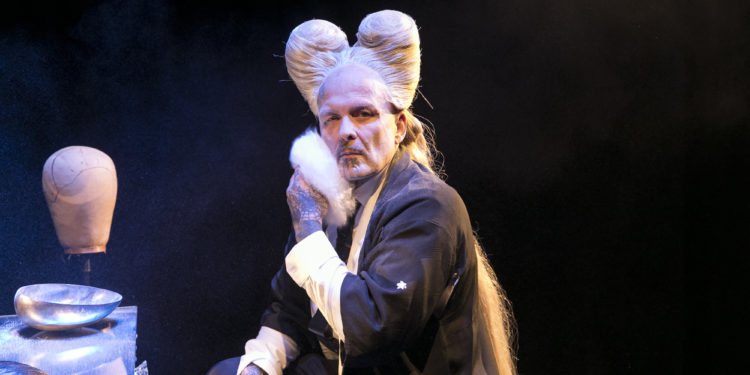By Ian Morton
What a difference 25 years makes. On July 25, 1994, North Carolina U.S. Senator Jesse Helms stood on the Senate floor, and used a performance photo of Ron Athey to attack funding through the National Endowment of the Arts (NEA). Although Athey had never actually received a grant or funding from the NEA, this contributed to Athey being blacklisted in the United States arts community for his controversial elements of BDSM, profuse bleedings and religion iconographies. On Nov. 24, fresh off a residency in Ireland, Athey was presented with the American Academy of Religion 2019 “Religion in the Art” award at the San Diego Convention Center. This annual award is presented to an artist, selected by a jury, “who has made a recent significant contribution to the understanding of the relations among the arts and religions.” I was fortunate enough to both sit down for a lunch interview with Athey, and to attend the Q&A session at which he was recognized for his work.
 Before reading another word of this column, I strongly encourage you to do a little research into Athey’s vast catalogue of performance art. There simply is no way for me to do even minimal justice to his aesthetic with writing, and simply typing “Ron Athey” into your YouTube search engine will bring up several options. Even this cannot offer the experience of live performance art, but it can provide some context for our conversations.
Before reading another word of this column, I strongly encourage you to do a little research into Athey’s vast catalogue of performance art. There simply is no way for me to do even minimal justice to his aesthetic with writing, and simply typing “Ron Athey” into your YouTube search engine will bring up several options. Even this cannot offer the experience of live performance art, but it can provide some context for our conversations.
We started our lunch conversation talking about his 1981 foray into performance art, and what he wanted to communicate as an artist.
“Something louder than a scream,” Athey replied, “With layers that can take [the audience] into a state.”
One of his earliest attempts was a collaboration with Rozz William, together performing as the experimental duo Premature Ejaculation. In the performance art world, Athey found a way to utilize the elements of his own Pentecostal upbringing to create his own lane in the Los Angeles punk world. Athey’s youth was spent in a religious community that performed religion as extreme pageantry — think tent meeting evangelism, Aimee Semple McPherson — and was “anointed as a prophet” at the age of 9. He experienced being rubbed with oil by the congregation, an aspect he later pulled into his own performance, to promote his gift of prophecy.
At 15, in the LA punk-rock scene, Athey found an artistic community that may not have been able to exist anywhere else, geographically. As he described it, “It’s ‘underground’ in the shadow of something as ‘mainstream’ as mainstream can get. You can meet all these beauties who came to be an actor or actress, but they didn’t make it, and their ‘second best’ turns into something weird and twisted.”
In this world, he found influences by artists like Johanna Went, Annie Sprinkle and authors like Jean Genet. Simultaneously, Athey was exposed to “body modification” in what were called “tabloid magazines,” which were centered in music, but also featured literature around extasis, BDSM and disassociation.
 These themes intersected with Athey’s own religious performative experiences and spoke to his fascination with the pageantry of religious iconography. Much inspiration has been pulled from stories and images of martyrs and saints, including the mortification of the body. St. Sebastian, traditionally depicted as being pierced with arrows, has been a recurring self-performed image in Athey’s work. This idea of being pierced and bleeding also connected with his performances centered around the HIV/AIDS epidemic, his own positive status, and the stigma that accompanied the disease. In his Q&A session, Athey expressed that he found himself asking questions, like, “What does healing look like?” as he witnessed the same sort of “snake-oil salesmanship” of “AIDS cures” being peddled that religious communities offered.
These themes intersected with Athey’s own religious performative experiences and spoke to his fascination with the pageantry of religious iconography. Much inspiration has been pulled from stories and images of martyrs and saints, including the mortification of the body. St. Sebastian, traditionally depicted as being pierced with arrows, has been a recurring self-performed image in Athey’s work. This idea of being pierced and bleeding also connected with his performances centered around the HIV/AIDS epidemic, his own positive status, and the stigma that accompanied the disease. In his Q&A session, Athey expressed that he found himself asking questions, like, “What does healing look like?” as he witnessed the same sort of “snake-oil salesmanship” of “AIDS cures” being peddled that religious communities offered.
Athey’s work has ranged from solo shows, having his own small company, collaborating with other artists, to performances that are staged as full-scale operas. During the 10 years Athey was blacklisted, he lived and performed abroad, and the range of influences in his body of work is evident. Themes from classical European iconography, Greek mythology and Egyptian garb are among the many aesthetics that Athey has reframed to illuminate contemporary issues. As well as pulling from artistic influences, Athey referenced his “biochemistry brain” (he worked at the Salk Institute for a time) and his study of Kabbalah and sex magick.
His most recent work, “Acephalous Monster,” is steeped in Nietzche’s prophecy of “1,000 years of chaos” after the fall of Western Religion, and incorporates text from Genesis P-Orridge’s collection, “Esoterrorist: Selected Essays 1980-1988,” in “cut-up” form. This multilayered performance positions Athey as “monsters,” mythological and historical, across centuries, and illuminates the threat of fascism in our current climate. About this piece, Athey asserts, “The myths and symbols of the past were attempts to articulate intimation of what is possible. The themes of mythology are not just archaic knowledge — they are living actualities of human beings.”
Having now leveraged his physical body toward the construction of performance art, Athey recognizes “it’s unnatural to turn yourself into an artistic object,” yet his nearly 40-year tenure speaks to a continued inspiration.
Senator Helms has not been, and will not be, the only critic of the “appropriateness” of Ron Athey’s art, but the artist knows who his work is for. He never set out to create performances to please the masses; as Athey contends, “The people I care about can respond to this work, because they are living it!”
Images and information can be found at ronathey.org and LTD Gallery in Los Angeles will host “Witness,” a retrospective reading of Athey’s texts from 1981- 2019 on Dec. 13. “Pleading In the Blood: The Art and Performances of Ron Athey” is a great text to explore, and there are many videos of performances and interviews to be found online.









